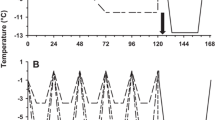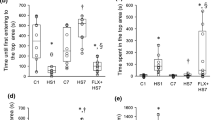Abstract
Single exposure of adult male rats to low environmental temperature (LET, 12 ± 0.5°C) for 2 h significantly increased the hypothalamic and striatal GABA levels without affecting those in other regions of brain. The activity of glutamate decarboxylase (GAD) was elevated in hypothalamus (H) and corpus striatum (CS) under these conditions. GABA accumulation rate (measured with ethanolamine-O-sulfate, an inhibitor of GABA-transaminase) was also increased in both H and CS of rats exposed to LET for 2 h. Unlike after a single exposure, the repeated exposure (2 h/day) for 7, 15, and 30 onsecutive days did not change the hypothalamic GABA metabolism. No change in GABA metabolism was observed in CS when rats were repeatedly exposed to LET for 7 consecutive days. Prolongation of repeated exposure to LET (2 h/day) for 15 and 30 consecutive days decreased the striatal GABA level and increased the activity of GABA-transaminase, although GAD activity was not altered under these conditions. These results suggest that single exposure to LET accelerates GABA synthesis and may reduce the GABAergic activity in both H and CS; whereas repeated exposure to LET for 15 or 30 consecutive days enhances GABAergic activity with the stimulation of GABA utilization only in CS without affecting its synthesizing process. Thus, it may be suggested that the hypothalamic and striatal GABA system may play a characteristic role in response to short-and long-term exposure to LET.
Similar content being viewed by others
References
Lomax, P., and Green, M. D. 1975. Neurotransmitters and temperature regulation. Prog. Brain Res. 12:251–261.
Siesjo, B. K. 1978. Hypothermia and hyperthermia. Pages 324–344,in Siesjo, B. K. (ed.), Brain Energy Metabolism, John Wiley and Sons, Chichester, New York, Brisbane, Toronto.
Leppaluoto, J., Korhonen, I., Huttunen, P., and Hassi, J. 1988. Serum levels of thyroid hormone and adrenal hormones testosterone, TSH, LH, GH and prolactin in men after a 2 h stay in a cold room. Acta Physiol. Scand. 132:543–548.
Von Euler, C. 1964. The physiology and pharmacology of temperature regulation. Pharmacol. Rev. 13:361–398.
Rivier, C., and Vale, W. 1987. Diminished responsiveness of the hypothalamic-pituitary aderenal axis of the rat during exposure to prolonged stress: A pituitary mediated mechanism. Endocrinology 121:1320–1328.
Yahata, T., Murazumi, K. and Kuroshima, A. 1987. Stress and cold induced adrenocortical responses in repetitively immobilized or cold-acclimated rats. Can. J. Physiol. Pharmacol. 65:1448–1460.
Golden, F. St. C., and Tipton, M. J. 1988. Human adptation to repeated cold immersions. J. Physiol. 396:349–364.
Soriano, F. J. L., and Alemany, M. 1988. Influence of cold exposure on liver amino acid metabolism enzymes of the rat. Biochem. Int. 16:1075–1082.
Corrodi H., Fuxe, K. and Hokfelt, T. 1968. Central serotonin neurons and thermoregulation. Adv in Pharmacol. 6B:49–54.
Cox B. and Lomax, P. 1977. Pharmacologic control of temperature regulation. Ann. Rev. Pharmacol. Toxicol. 17:341–353.
Baldino, F. Jr. 1986. Norepinephrine suppression of neuronal thermosensitivity. Pages 99–102,in Cooper, K., Lomax, P., Schonbaum, E., and Veale, W. L. (eds.), Homeostasis and Thermal Stress, Karger, Basel.
Poddar, M. K., Mukhopadhyay, S., and Ray, S. K. 1986. Environmental temperature-induced regional changes in brain dopaminergic activity. Pages 133–136,in Cooper, K., Lomax, P., Schonbaum, E. and Veale, W. L. (eds.), Homeostasis and Thermal Stress, Karger, Basel.
Mukhopadhyay, S., and Poddar, M. K. 1988. Environmental temperature induced change in brain regional serotonergic activity. Biogenic Amines 5:505–516.
Poddar, M. K. and Mukhopadhyay, S. 1989. Synaptosomal membrane-bound (Na+−K+)-ATPase: Effect of higher environmental temperature. J. Neurochem. 52(suppl):170.
Gordan, R., Spector, S., Sjaerdsma, A., and Udenfried, S. 1966. Increased synthesis of norepinephrine and epinephrine in the intact rat during exercise and exposure to cold. J. Pharm. Exp. Therp. 153:440–447.
Bliss, E. J., Ailion, J., and Zwanzider, J. 1968. Metabolism of norepinephrine, serotonin and depamine in rat brain with stress. J. Pharmacol. Exp. Therap. 164:122–134.
Tomitaro, K., Hata, T., Higashiguchi, T., Itoh, E., and Kawabuta, A. 1986. Changes of total acetylcholine content and the activity of related enzymes in specific alteration of rhythm in environmental temperature (repeated cold)-stressed rat brain and duodenum. Jap. J. Pharmacol. 40:174–177.
Hata, T., Kita, T., Kamanaka, Y., Honda, S., Kakchi, K., Kawabata, A., and Itoh, E. 1987. Catecholamine levels in the brain of SART (repeated cold)-stressed rats. J. Autonomic Pharmacol 7:257–266.
Kuriyama, K., Haber, B., Sisken, B., and Roberts, E. 1966. The γ-aminobutyric acid system in rabbit cerebellum. Proc. Natl. Acad. Sci. USA. 55:846–852.
Roberts, E. 1974. γ-aminobutyric acid and nervous system function —A perspective. Biochem. Pharmacol. 23:2637–2649.
McGeer, P. L., Eccles, J. C., and McGeer, E. G. 1978. Inhibitory amino acid neurons: GABA and glycine. Pages 199–231,in McGeer, P. L., Eccles, J. C., and McGeer, E. G. (eds.), Molecular Neurobiology of the Mammalian Brain, Plenum Press, New York.
Joffe, R. T., Pot, R. M., Rubinow, D. R., Berrettini, W. H., Hare, T. A., Ballenger, J. C., and Ray-Byrne, P. P. 1986. Cerebrospinal fluid GABA in manic-depressive illness. Pages 187–194,in Bartholini, G., Lloyd, K. G. and Morselli, P. L. (eds.), GABA and mood Disorders, Raven Press, New York.
Yoneda, Y., Kanmori, K., Ida, S., and Kuriyama, K. 1983. Stress-induced alterations in metabolism of GABA in rat brain. J. Neurochem. 40:350–356.
Schwartz, R. D., Wess, M. J., Labarea, R., Skolnick, P., and Paul, S. M. 1987. Acute stress enhances the activity of the GABA receptor gated chloride ion channel in brain. Brain Res 411:151–155.
Biswas, S., and Poddar, M. K. 1988. Involvement of GABA in environmental temperature-induced change in body temperature. Meth. Find. Exp. Clin. Pharmacol. 10:747–749.
Biswas, S., and Poddar, M. K. 1989. Effect of higher environmental tempeerature on diazepam-induced changes in brain regional GABA. Biogenic Amines 6:581–590.
Otero Losada, M. E. 1988. Changes in central GABAergic function following acute and repeated stress. Brit. J. Pharmacol. 93:483–490.
Poddar, M. K., and Dewey, W. L. 1980. Effects of cannabinoids on catecholamine uptake and release in hypothalamus and striatal synaptosomes. J. Pharm. Exp. Therap. 214:63–67.
Lowe, I. P., Robins, E., and Eyerman, G. S. 1958. The fluorimetric measurement of glutamic decarboxylase and its distribution in brain. J. Neurochem. 3:8–18.
MacDonnell, P., and Greengard, O. 1975. The distribution of glutamate decarboxylase in rat tissues: isotopic vs. fluorometric assays. J. Neurochem. 24:615–618.
Sytinsky, I. A., Guzikov, B. M., Gomanko, M. V., Eremin, V. P., and Konovalona, N. N. 1975. The gamma aminobutyric acid (GABA) system in brain during acute and chronic ethanol intoxication. J. Neurochem. 25:43–48.
Lowry, O. H., Rosebrough, N. J., Farr, A. L. and Randall R. J. 1951. Protein measurement with Folin-phenol reagent. J. Biol. Chem. 193:265–275.
Leach, M. J. and Walker, J. M. G. 1977. Effect of EOS on regional GABA metabolism in mouse brain. Biochem. Pharmacol. 26:1569–1572.
Thierry, A., Javoy, F., Glowinski, J., and Kety, S. 1968. Effects of stress on the metabolism of norepinephrine, dopamine and serotonin in the central nervous system of the rats J. Pharmacol. Exp. Ther. 163:163–171.
Floran, B., Arias, A., Sierra, A., Martinez-Fong, D., and Acenes, J. 1988. Dopamine modulates GABA release inthe pars reticulata of the rat substantia nigra. Soc. Neurosci. 14:348.
Kuriyama, K., Kanmori, K., Taguchi, J. and Yoneda, Y. 1984. Stress-induced enhancement of suppression of [3H]-GABA release from striatal slices by presynaptic autoreceptor. J. Neurochem. 42:943–950.
Pittaluga, A., Asaro, D., Pellegrin, G., and Raiteri, M. 1987. Studies on tritiated GABA and endogenous GABA release in rat cerebral cortex suggest the presence of autoreceptors of the GABA type. Eur. J. Pharmacol. 144:45–52.
Scheel-Kruger, J., and Magelund, G. 1981. GABA in the entopeduncular nucleus and the subthalamic nucleus participates in mediating dopaminergic striatal output functions. Life Sci. 29:1555–1562.
Scheel-Kruger, J. 1982. GABA: an essential moderator and mediator in the basal ganglia system of dopamine related functions. Acta Neurol. Scand. 65 (Suppl. 90), 40–45.
Appelgren, G., Eriksson, S., and Sjcstrand, N. O. 1982. Commentary on the reduced urinary noradrenaline excretion following cold stress and exercise in physically treated rats. Acta Physiol. Scand. 114:579–585.
Dallman, M. F. and Jones, M. T. 1973. Corticosteroid feedback control of ACTH secretion: effect of stress-induced corticosterone secretion on subsequent stress response in the rat. Endocrinology 92:1367–1369.
Young, E. A., and Akil, H. 1985. Contricotropin-releasing factor stimulation of adrenocorticotropin and beta endorphin release effects of acute and chronic stress. Endocrinology 117:23–30.
Majewska, M. D., Bisserbe, J. C. and Eskay, R. L. 1985. Glucocorticoids are modulators of GABA receptors in brain. Brain Res. 339:178–182.
Author information
Authors and Affiliations
Rights and permissions
About this article
Cite this article
Biswas, S., Poddar, M.K. Effect of short-and long-term exposure to low environmental temperature on brain regional GABA metabolism. Neurochem Res 15, 815–820 (1990). https://doi.org/10.1007/BF00968559
Accepted:
Issue Date:
DOI: https://doi.org/10.1007/BF00968559




